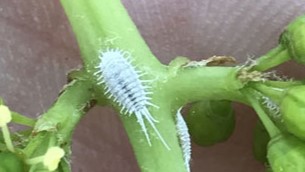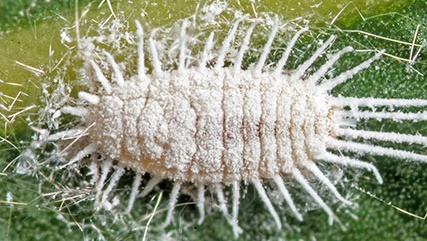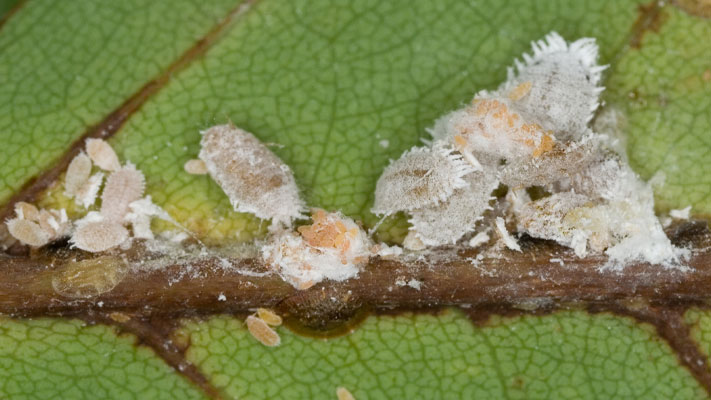Tuber mealybug
Pseudococcus viburni
Tuber mealybugs, also known as obscure mealybugs, are often confused with the more prevalent longtailed mealybugs. Tuber mealybugs are a pest in some grape growing regions of eastern Australia and parts of south west Western Australia. Found in all States and Territories, they are a significant pest of pome and stone fruit orchards and inland citrus crops.
Refer to the links below on different mealybug species.
Refer to the links below on different mealybug species.

Description
Tuber mealybugs have a thin waxy coating which covers their light grey body. They have short, thin tail filaments and when squashed they have orange body contents. Adult female tuber mealybugs lay a fibrous silky or cottony egg sac containing up to 600 yellow to brown oval shaped eggs which hatch as mobile crawlers over a number of days.
Damage by tuber mealybugs is similar to that caused by longtailed mealybugs in that they feed on the plant’s sap, excreting honeydew as a by-product of their feeding. The honey dew provides a medium for sooty mould to grow on and a food source for ants. This contamination of fruit with sooty mould can impact fermentation for wine grapes or lead to a down-grading of fruit.
Control
Mealybugs can be controlled by encouraging predators such as ladybird beetles, predatory beetles, lacewing larvae and parasitoid wasps and by the considered use of insecticides, targeted at the juvenile life stages. However, focusing control on chemicals can be problematic for a number of reasons as their waxy coating repels sprays and spray contact can be difficult. It is therefore important to strategically apply an insecticide based on its attributes.Movento® being a systemic product should be targeted at the juvenile pest stage allowing the insect to ingest the product through feeding on the plant parts. Movento is soft on many beneficial insects, including parasitic wasps, pirate bugs, hoverflies and lacewings. It is registered for the control of tuber mealybugs in grapes, pome and stone fruit and should be applied at the onset of crawler emergence.
References
Australian Wine Research Institute (2011), ‘Viti-Notes: Pests and Diseases: Mealybugs’, https://www.awri.com.au/wp-content/uploads/mealybug.pdfSouth Australia Research & Development Institute (2016), ‘Fact Sheet: Identifying Mealybugs on Inland Australian Citrus, PIRSA, https://www.pir.sa.gov.au/__data/assets/pdf_file/0007/285532/Identifying_Mealybugs_on_Inland_Australian_Citrus_Fact_Sheet.pdf
DPIRD (2018), ‘Mealybugs in grapevines and deciduous tree crops’,
https://www.agric.wa.gov.au/minor-fruits/mealybugs-grapevines-and-deciduous-fruit-tree-crops?nopaging=1







